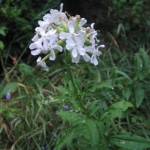| Common Name: |
Bouncing Bet |
| Other Names: |
Bruisewort, Crow Soap, Dog Cloves, Fuller's Herb, Latherwort, Old Maid's Pink, Soap Root, Soapwort |
| Botanical Name: |
Saponaria officinalis |
| Genus: |
Saponaria |
| Family: |
Caryophyllaceae |
| Native Location: |
Europe, Naturalized in N America |
| Cultivation: |
Well-drained, moist, neutral to alkaline soil in sun or partial shade. May be invasive. Poisonous to fish; roots or foliage should not contact pond water. |
| Propagation: |
By seed sown in autumn or spring (species only); by division in autumn or spring. |
| Harvest: |
Leafy stems are collected in summer, rhizomes in late autumn. Both are dried for decoctions. |
| Height: |
30-90cm (12-36in) |
| Width: |
60cm (24in) |
| Variations: |
Alba Plena
Has double white flowers. |
Dazzler
Syn. Taff's Dazzler, Variegata
Has irregularly cream-variegated leaves and single pink floer. Tends to revert. |
Rosea Plena
Has double, pale pink flowers. |
Rubra Plena
Has double, deep pink flowers. |
|
| Hardiness: |
Z2-8 |
| History: |
This pink-flowered perennial has been used as a soap, shampoo, and commercial cleaning product for almost 3,000 years. Its genus name comes from the Latin sapo, for "soap", and is a reference to the plant's high concentrations of soaplike saponin. (In fact, "saponification" is the technical term for making soap.) Among museum curators soapwort is still prized as a gentle cleaning agent for antique fabrics, furniture, paintings, and tapestries. One of the plant's common names, fuller's herb, is a derivation of soapwort's medieval name, herba fullonis, a reference to the fact that the plant was used to thicken (of "full") wool by "fullers"—tradespeople who "fulled" course fabric by moistening, heating, and pressing it. Soapwort was also the treatment of choice for syphilis when the older—and more dangerous—mercury method failed. Early American settlers brought soapwort to the United States, where it was popularly known as bouncing Bet, and used it as a diuretic, and a treatment for skin ailments. The Pennsylvania Dutch went a step further and used soapwort to add a foamy head to their home-brewed beers. |
| Parts Used: |
Leafy stems, Rhizomes |
| Properties: |
A diuretic, laxative, expectorant herb that clears toxins, and stimulates the liver. |
| Medicinal Uses: |
Internally for gout and skin diseases, bronchial congestion, and jaundice. Rarely used today due to its irritant effect on the digestive system. Externally for skin diseases.
Soapwort has diuretic, expectorant, laxative, and liver-stimulating properties. It also increases the flow of bile to the intestines and helps rid the body of toxins. Folk herbalists prescribed soapwort internally to treat chest congestion, constipation, gout, jaundice, and syphilis. While some traditional herbalists still use small quantities of soapwort (in decoctions) to treat gout, jaundice, and upper respiratory ailments, most herbalists generally recommend soapwort for external use only. It is an effective treatment for acne, dermatitis, eczema, itching, minor rashes and skin irritations, psoriasis, and rheumatic pain and stiffness. |
| Preparation: |
Soapwort is available as dried herb and in oils, shampoos, soaps, and tinctures. To make a decoction—for external use only—boil 2 teaspoons of dried rootstock in 1 cup of water for 10 to 15 minutes. Allow to cool before applying to skin, either directly or in a compress. |
| Economic Uses: |
Extract is used as an emulsifiers in Middle Eastern candy known as halva, based on sesame seeds; also in Ukraine to a similar product made from sunflower seeds. Dried herb is used as a soap substitute for delicate materials, and as an ingredient of natural shampoos. |
| Warning: |
Irritant to digestive system. Excess destroys red blood cells and causes paralysis of the vasomotor center.
Soapwort solutions are irritant to eyes.
Only use soapwort externally, and be cautious when applying it to the skin. The herb contains saponins that should not be used on broken skin; they dissolve red blood cells. |
| Bibliography: |
Encyclopedia of Herbs by Deni Brown Copyright © 1995, 2001 Dorling Kindersley Limited. pg 360
The Modern Herbal Primer by Nancy Burke Copyright©2000 Yankee Publishing, Inc. pg. 97 |
